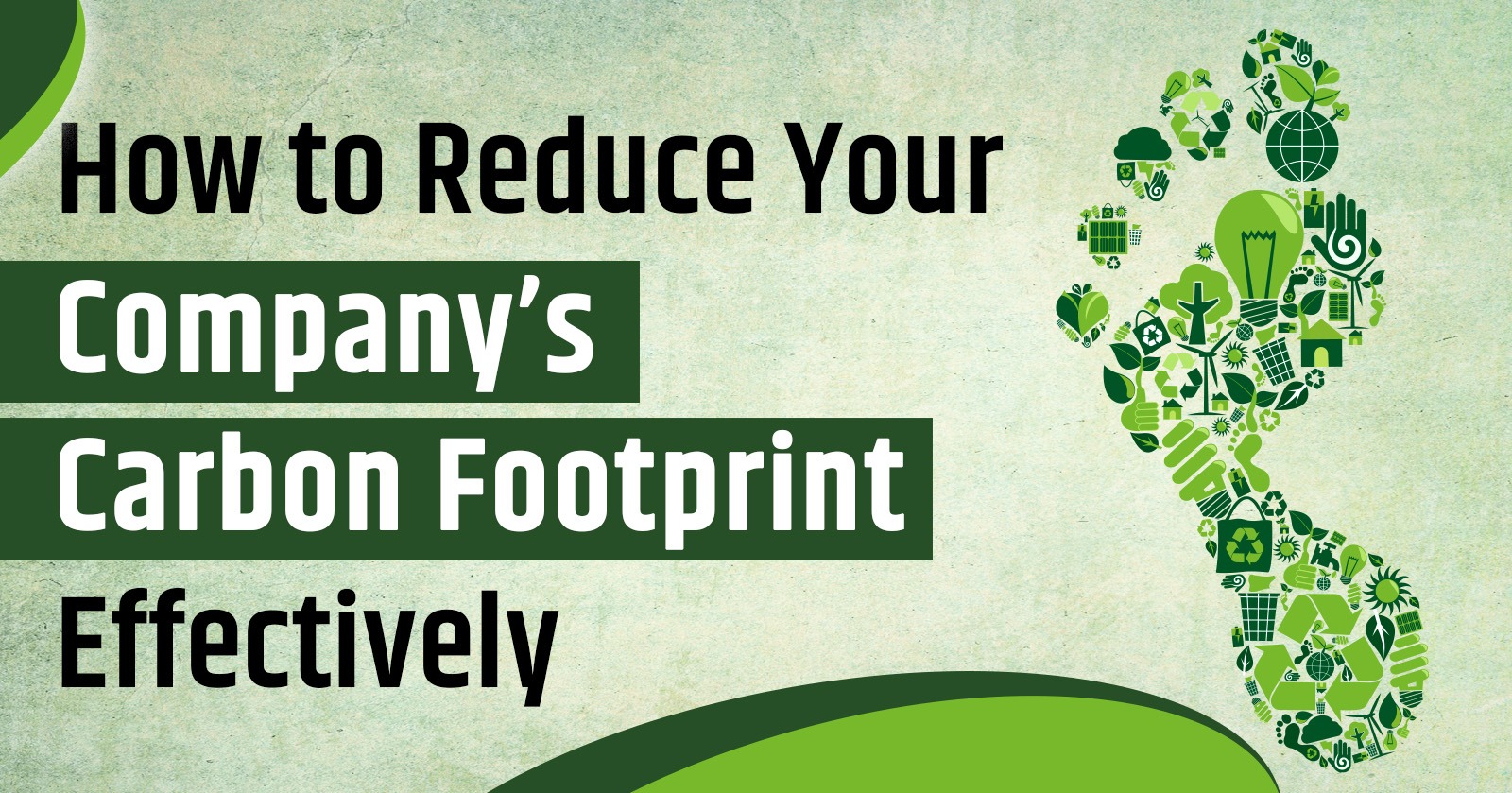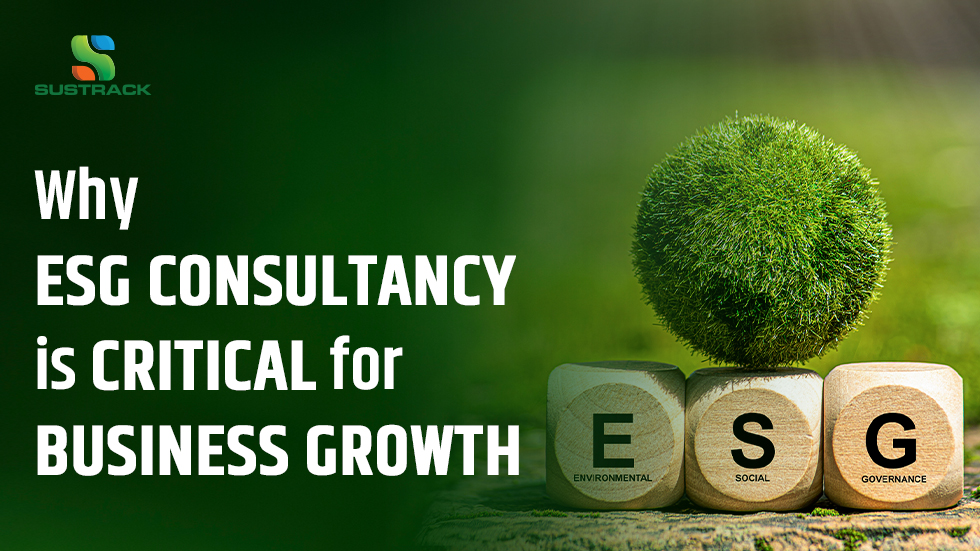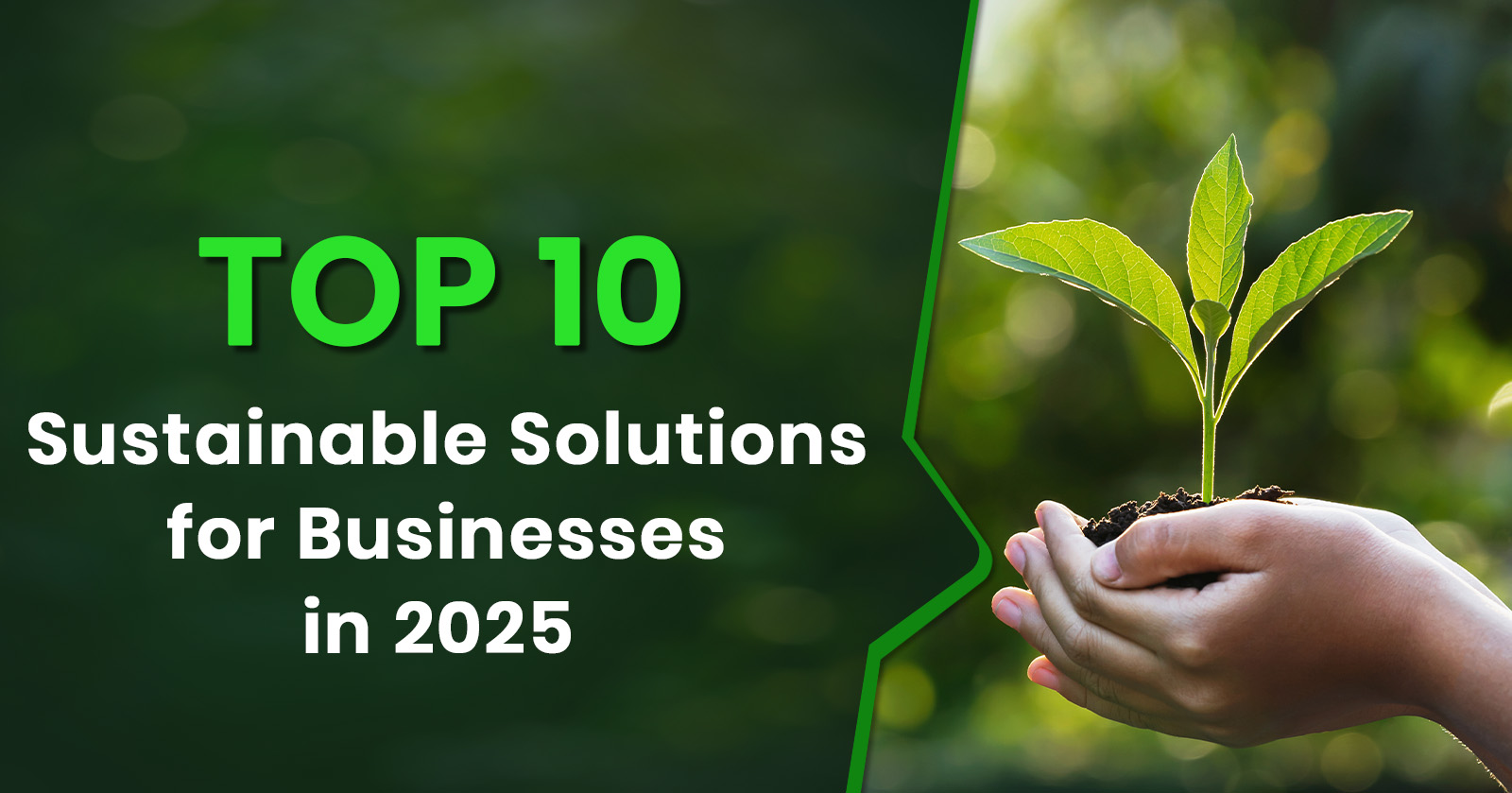How to Reduce Your Company’s Carbon Footprint Effectively?

Carbon Footprint reduction isn’t just good for the planet; it is also an innovative business. As sustainability has become a key differentiator, companies are now in need of clear strategies to cut emissions and stay competitive. This blog outlines practical, actionable steps that can help companies reduce their carbon footprint, comply with evolving standards, and strengthen their market position.
Definition and impact of corporate Carbon Footprints
A corporate carbon footprint is the total amount of Greenhouse Gas (GHG) emissions, which is measured in carbon dioxide equivalent (CO2e), that a firm emits directly and indirectly through its functional body, including energy use, manufacturing, transportation, supply chains, employee commuting, and waste generation. Likewise, the impact that Corporate Carbon Footprints make is as follows:
The Impact of Corporate Carbon Footprints
- Environmental Impact: Corporate carbon emissions significantly contribute to Air Pollution, Global Warming, and Climate Change, which leads to more frequent extreme weather events and Biodiversity loss.
- Regulatory Risks: The Government of India is introducing stricter Carbon emission regulations and reporting mandates, which are pushing companies to track & reduce emissions or face penalties.
- Reputational Risk: According to ESG reporting, a company with a large carbon footprint can damage its goodwill in the public eye, especially among eco-conscious customers and investors who favour environmentally responsible brands.
- Financial Costs: The companies with significant emissions may face increasing costs through carbon footprint taxes, energy efficiency, and unsustainable practices that increase long-term operational costs.
- Market Competitiveness: Companies that focus on reducing their carbon footprints often gain a competitive edge by improving efficiency, innovating products, and aligning with the global sustainability trends.
What are the Measuring Scope 1, 2, and 3 emissions in ESG?
The scopes 1,2, and 3 emissions in ESG (Environmental, Social, and Governance) frameworks are the major categories used to measure and report a company’s Greenhouse gas (GHG) emissions. These scopes are defined by the Greenhouse Gas Protocol, the most widely used international accounting tool for governments and business leaders to understand, quantify, and manage GHG emissions.
Scope 1: Direct Emissions
These GHG reductions are achieved through direct emissions from the sources that the firms directly control.
The examples are as follows:
- The fuel combustion occurs through the vehicles or water boilers.
- Carbon emissions from the manufacturing process are On-site.
- The fugitive carbon emissions from refrigeration or industrial processes.
The above-mentioned pointers are the under control emissions for an organisation.
SCOPE 2: The Indirect Emissions from Purchased Energy.
In this segment, the emissions are produced through the purchased properties, such as electricity, steam, heating & cooling that the Company & its employees consume.
The examples are as follows:
- The carbon footprint emissions from the usage of the Power Plants that generate the electricity used indirectly in Offices or Factories.
The Firms can reduce Scope 2 emissions by adopting renewable energy sources or increasing energy efficiency.
SCOPE 3 part, the Indirect Emissions in the Value Chain.
These are all the other indirect emissions that occur outside a Firm’s operations but are related to its subordinate segment, both upstream & downstream.
The examples are as follows:
- The carbon footprint emissions from the suppliers, such as raw materials.
- Carbon emissions through commuting and business travel
- The product use and end-of-life disposal
- Carbon emissions from logistics and transportation by third parties.
As we talk about SCOPE 3, it is often the most significant segment that emits carbon footprints and also the hardest to measure and control.
Why Measuring all Three Scopes Matters in ESG Reporting?
The importance of these three Scopes in ESG reporting is as follows:
- The transparency & accountability that stakeholders and investors expect through ESG reporting require that all emissions be visible in the ESG report.
- Through the ESG compliance requirement of many ESG reporting standards, such as BRSR & GRI.
- In the Strategic Reduction, identifying large emissions areas helps in designing targeted GHG reduction strategies.
- The investors’ confidence is maintained accurately. The scope data presents a commitment to sustainability and risk management.
What Tools and strategies for reduction are used in ESG reporting?
In the sustainability reporting, there is a variety of tools & strategies that are used to curb the carbon footprints, helping organisations in measuring, managing & minimising their environmental impact, particularly the GHG emissions. Below is a structured breakdown of the most commonly used tools and strategies during Sustainability reporting:
Tools for Carbon Measurements & ESG reporting:
- GRI Reporting Framework (Global)
a). This ESG framework is widely adopted as a global standard for emissions accounting.
b). It helps in calculating the three ESG Scopes 1, 2, and 3 emissions.
- BRSR Framework (India-Specific)
a). This framework integrates environmental, social, and governance disclosures.
b). It requires companies to report on energy usage, emissions, water, waste, and sustainability targets.
c). It also aligns with the global standards like GRI, SASB & TCFD.
d). The BRSR framework encourages Indian companies to track & reduce their carbon footprint in a structured and transparent manner.
- CDP (Carbon Disclosure Project) Framework
a). The framework discloses the climate-related risks, emissions data, and reduction plans.
b). This GHG reduction framework is used by the investors & regulators to assess climate action transparency.
- SBTI (Science-Based Targets Initiative)
a). This sets the target aligned with climate science and the Paris Agreement.
b). It provides guidance on the GHG reduction pathways.
- Carbon Accounting Software
a). This tracks down the real-time carbon emission performance across operations and supply chains.
b). Automated data collection, carbon emission calculations, and ESG reporting.
- ESG Reporting Frameworks
a). GRI (Global Reporting Initiative)
b). SASB (Sustainability Accounting Standards Board)
c). TCFD (Task Force on Climate-related Financial Disclosures)
This ESG Reporting Framework helps in standardising disclosure and linking it to climate-related risk management.
The Strategies for Carbon Footprint Reduction
Energy Efficiency Improvements
- The LED lighting, innovative energy management systems, and efficient HVAC (Heating, Ventilation, and Air Conditioning) systems.
- The retrofitting of buildings and the upgrading of industrial equipment.
Renewable Energy Adoption
- By installing Solar panels & purchasing green energy (For example, a Biogas plant)
- Transitioning to renewable sources for electricity and heating.
Sustainable Supply Chain Management
- Partnering with vendors with low-carbon emissions.
- Encouraging the suppliers and manufacturers to track and reduce their carbon footprint.
Sustainable Transportation
- Electrifying fleet vehicles.
- Promoting employee carpooling, cycling, or remote work for GHG reduction.
Carbon Offsetting
- Here, investing in reforestation, clean energy, or verified carbon credit programs.
- Used as a last resort when emissions cannot be eliminated.
Circular Economy Practices
- In this, reducing waste, recycling materials, and reusing components.
- Designing products for durability and end-of-life recovery.
The employee engagement & green culture
- In this, the training programs are designed to foster sustainable behaviour.
- Incentives for emission-reducing initiatives within departments.
Why do these tools & strategies Matter?
The reasons why these sustainability reporting tools & strategies are as follows:
- To ensure regulatory compliance and avoid penalties.
- Building investor & customer trust through transparent ESG action.
- These sustainability reporting tools & strategies enhance operational efficiency and reduce long-term costs.
- It supports net-zero and climate commitments.
What is the ESG consultancy role in carbon management?
The ESG consultancy has an essential role in helping organisations understand, measure, and reduce their carbon footprint as part of a broader sustainability strategy. Here’s how the companies support carbon emission management at each stage:
- Carbon Footprint Assessment
- Conducting the baseline assessments of Scope 1, 2, and 3 emissions using tools like the GHG reduction.
- They identify the key emission sources across operations, supply chains, and products.
- It ensures compliance with BRSR (India), CDP, GRI reporting, TCFD, and SBTI frameworks.
- Strategy Development & Target Setting
- Under this, they develop a customised GHG reduction roadmap aligned with the organisation’s goals and industry best practices.
- They also support the organisation in setting up the science-based targets for GHG reduction.
- The ESG consultants help in integrating carbon goals into broader ESG and CSR strategies.
- Implementation of GHG Reduction Initiatives
- They also help in recommending the energy efficiency upgrades and adopting renewable energy and green supply chain practices.
- Also, guides the employees’ engagement and internal carbon management programs.
- They support the circular economy transitions, sustainable mobility planning, and GHG reduction investments.
- Implementation of Reduction Initiatives
- Recommends energy efficiency upgrades, renewable energy adoption, and green supply chain practices.
- Supports circular economy transitions, sustainable mobility planning, and carbon offset investments.
- Guides employee engagement and internal carbon management programs.
Why ESG Consultancy is Essential in Carbon Management
- Offers expertise, objectivity, and tools that businesses often lack in-house
- Accelerates decarbonization journey with measurable results
- Enhances investor confidence and future-proofs the business against climate risks
Sustrack’s Carbon Solutions
We empower organisations to navigate the path to net-zero emissions through our comprehensive and science-driven Carbon Management Solutions. Our approach is tailored to meet the evolving ESG landscape and regulatory expectations, while creating long-term value for businesses and the planet.
Our Core Carbon Services Include:
- Carbon Footprint Assessment
- Accurate measurement of Scope 1, 2, and 3 emissions
- Aligned with GHG Protocol, BRSR, and global ESG frameworks
- Customised baseline studies across operations, supply chain, and products
- Carbon Strategy & Net-Zero Roadmap
- Development of achievable emission reduction targets
- Alignment with the Science-Based Targets Initiative (SBTi)
- Integration of carbon goals into broader sustainability and ESG strategy
- Emission Reduction Advisory
- Sector-specific recommendations for reducing energy use, fuel consumption, and waste
- Guidance on renewable energy, sustainable logistics, and circular economy practices
- Green supply chain transformation
- Carbon Offset & Neutrality Planning
- Identification of credible carbon offset projects (reforestation, clean energy, etc.)
- Support in achieving carbon neutrality and net-zero certification
- Carbon Reporting & Compliance
- Preparation of disclosures for BRSR, CDP, GRI, TCFD, and SASB
- ESG data management and stakeholder reporting
- Audit-ready documentation and compliance assurance
Why Choose Sustrack?
- End-to-end carbon solutions from measurement to reporting
- Alignment with both Indian (BRSR) and global ESG standards
- Customised, sector-specific strategies for measurable impact
Conclusion
This is a significant drawback for a Company that generates a Carbon Footprint. Here’s an ESG Consultancy that plays a vital role by guiding Organisations in curbing their carbon emissions by providing various services related to climate strategy and climate action, GHG reduction, etc. An ESG roadmap is prepared to enlighten organisations, and a tentative plan for the next few years is given to reduce carbon footprints and the positive outcome that will come from their actions. Now is your turn to get your carbon emissions reduced.
Frequently Asked Questions
What is a climate strategy for a business?
A climate strategy is a planned-out structure that outlines how a business can meet its GHG reduction goals, and adapt to climate risks through applying climate actions, and align with global climate action goals such as the Paris Agreement. It involves targets, timelines, and actionable steps to manage environmental impact and build long-term sustainability.
How does Sustrack help businesses with climate strategy?
Sustrack provides hurdle-free end-to-end support from scratch, including the carbon baseline studies and risk assessment strategy formulation, implementation, and compliance reporting. The team ensures your climate strategy aligns with climate action, with both the regulatory & global sustainability goals.Carbon Footprint reduction isn’t just good for the planet; it is also an innovative business. As sustainability has become a key differentiator, companies are now in need of clear strategies to cut emissions and stay competitive. This blog outlines practical, actionable steps that can help companies reduce their carbon footprint, comply with evolving standards, and strengthen their market position.



